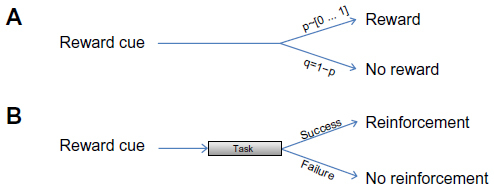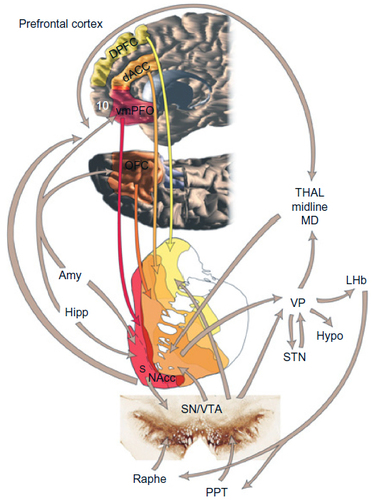Notes: Reprinted by permission from Macmillan Publishers Ltd:
Neuropsychopharmacology. Haber SN, Knutson B. The reward circuit: linking primate anatomy and human imaging.
Neuropsychopharmacology. 2010;35(1):4–26.
Citation9 Copyright © 2010. Evidence from self-stimulation, pharmacological, physiological, and behavioral studies emphasizes the key role of the nucleus accumbens and the ventral tegmental area dopamine neurons in the human reward circuit. However striatal and midbrain areas involved during reward processing are more extensive than previously thought, including the entire ventral striatum and the dopamine neurons of the substantia nigra, respectively. Thereby, the orbital frontal cortex (dark orange arrow) and the anterior cingulate cortex (light orange arrow) provide the main cortical input to the ventral striatum. Moreover, the ventral striatum receives substantial dopaminergic input from the midbrain. On the other hand, ventral striatum projections target the ventral pallidum and the ventral tegmental area/substantia nigra, which, in turn, via the medial dorsal nucleus of the thalamus, project back to the prefrontal cortex. Additionally, other structures, such as the amygdala, hippocampus, lateral habenular nucleus, and specific brainstem structures, such as the pedunculopontine nucleus and the raphe nuclei, play a key role in the regulation of the reward circuit.
Abbreviations: Amy, amygdala; Hipp, hippocampus; NAcc, nucleus accumbens; dACC, dorsal anterior cingulate cortex; dPFC, dorsal prefrontal cortex; Hypo, hypothalamus; S, shell; STN, subthalamic nucleus; VP, ventral pallidum; vmPFC, ventral medial prefrontal cortex; THAL, thalamus; LHb, lateral habenular; PPT, pedunculopontine nucleus.


